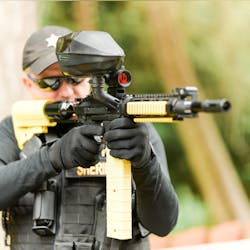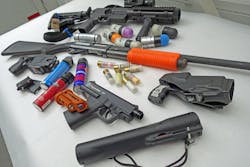Less Lethal Weapon Integration Requires Research, Training
Less lethal is a classification of weapons designed to bridge the gap between traditional batons and firearms. Historically, these options have been in the shadows of American law enforcement, utilized mainly for civil disturbances and special operations. In the early 2000s, the TASER (Axon) redefined how street officers dealt with resistive subjects. With increased media and public attention of high profile police encounters, especially with the mentally ill, there is now an expectation that some form of less lethal option will be available to the first responding officers in an attempt to deescalate dangerous situations.
Like most things, adding a less lethal system is more complicated than it appears on the surface. A long time less lethal enthusiast, Commander Sid Heal, often said: “…there is no panacea!” As we sat on a NIJ less lethal board years ago, we often discussed qualities of the perfect non-lethal weapon and the pros and cons of what currently exists on the market. The biggest challenge for administrators, risk managers and trainers is selecting the best available less lethal option to put on officer’s belts or in the trunks of their cruiser. After proper evaluation and vetting, they must all work together to weave the weapon into the culture of the department, their training program and after-action inquiry.
A lack of less lethal standards
Not unlike use-of-force policies throughout the U.S., there are no national standards for what a less lethal weapon should do to a person. There are certainly some guidelines put forth by professional organizations like IACP, PERF and ILEETA, but it is difficult to place a deployment standard on a less lethal device that will affect people in different ways. There are no benchmarks on targeting, minimal and maximum ranges, energy transfer, construction, size, shape, power and wounding limits of these weapons. What is an acceptable injury from a less lethal weapon? These weapons are occasionally evaluated by independent laboratories, but a majority of agencies rely on the manufacturer for safety margins and deployment recommendations.
Generally speaking, options available for the patrol officer come in three categories: impact, chemical and electrical.
The impact varieties are intended to deliver a minor blunt injury for pain compliance with everything from 12-gauge rubber buckshot and bean bags to 40mm sponge rounds.
Electronic counter measures, most commonly referred to as conducted electrical devices (TASERs), are arguably the most common less-lethal option. They can incapacitate a subject and do not typically rely on pain compliance like other less lethals, although they carry their share of controversy.
Regardless of what is chosen, there is liability and risk associated with all of their uses. Whether real or perceived, these concerns must be addressed in policy and in training. Not just training the operators that deploy them, but the investigators that pick up the pieces and the administrators that explain them to the press.
It’s easy to get caught up in the magic of deploying a unique device that no other department is using. As mentioned, there are no national standards, anyone can create the latest mousetrap and convince a chief to buy it. Administrators can be influenced by the cost, uniqueness and claimed safety of a weapon without knowing its true capabilities and limitations. The department is forced to rely solely on the manufacturer for its relative safety to proven less lethal systems. Being the tip of the spear for a new device has worked out very poorly for some agencies, with outcomes and injuries that were not foreseen, resulting in a sizeable payout during civil litigation.
Choose and train for success
Adding a less lethal weapon to the toolbox will unquestionably add cost for departments, not only for the equipment itself, but for additional training for operators. It’s imperative that the new system does more good than harm when deployed, but the threshold for which these weapons can be deployed is greatly variable and often their justification is up for interpretation. It must be considered that less lethal deployments could increase liability on departments and in some cases more than lethal force would incur.
The instructor class for a particular modality is normally one to two days and typically live fire involves a static target with training rounds. Albeit a cost savings, training rounds often do not possess the same qualities. It is essential that departments deploy duty rounds in training of operators as well as incorporating a dynamic component (role playing, decision-making exercises).
For impact munitions, the point of aim, point of impact and flight characteristics can be different. A smart evaluation can be done with relatively inexpensive measuring tools, such as chronographs and human tissue simulants. It is crucial that operators understand the complete and realistic capabilities of what they fire at people. Additionally, scenario-based and practical use-of-force training integrating less lethal deployments have proven successful to cultivate good decision-making during incidents. We assisted in role-playing training for Seattle PD years ago where the officer enters a room with a suicidal subject. The subject has a gas can (full of water) and proceeds to threaten his life as well as the officer’s with a fireball. Do the officers deploy their TASER in a flammable environment? If yes, fail. What if there is no gas can and the TASER is simply ineffective? Could a TASER deployment actually make a person more agitated? What is the next action you take?
It is routinely discussed in our courses that the importance of police training is frequently overlooked until a large use-of-force payout is made. Some agencies see training and the legal aspect of a deployment as two separate sides of the house along with two different buckets of money. Training for dynamic deployments is only half of the formula for success, as proper collection of evidence, forensic analysis and investigation after a deployment can greatly affect whether the program remains in place. Applying what is gleaned from the successes and failures of a particular device before the lawsuit is truly the key to reduced long term liability.
About the Author
R.T. Wyant is a supervising forensic scientist, reserve deputy and international expert on the testing, evaluating and the post-event analysis of less-lethal options. He has certified as an instructor in several less-lethal modalities and is a certified NTOA less-lethal instructor. He is the co-author of “Risk Management of Less Lethal Options: Evaluation, Deployment, Aftermath, and Forensics” (ISBN: 978-1-4665-6303-2).
8 Tips For A Successful Less Lethal Program
- Independent evaluation of selected tool (science it up!)
- Verified accuracy, consistency and reliability
- Scenario-based training for operators and support officers
- Train for outcomes that are less than ideal, that may escalate
- Thorough and educational after-action reports
- Education of public information, administrators, investigators
- Forensic collection and analysis of incident
- Integrate outcome of deployments into training
About the Author
R.T. Wyant
R.T. Wyant is a supervising forensic scientist, reserve deputy and international expert on the testing, evaluating and the post-event analysis of less-lethal options. He has certified as an instructor in several less-lethal modalities and is a certified NTOA less-lethal instructor. He is the co-author of “Risk Management of Less Lethal Options: Evaluation, Deployment, Aftermath, and Forensics” (ISBN: 978-1-4665-6303-2).

